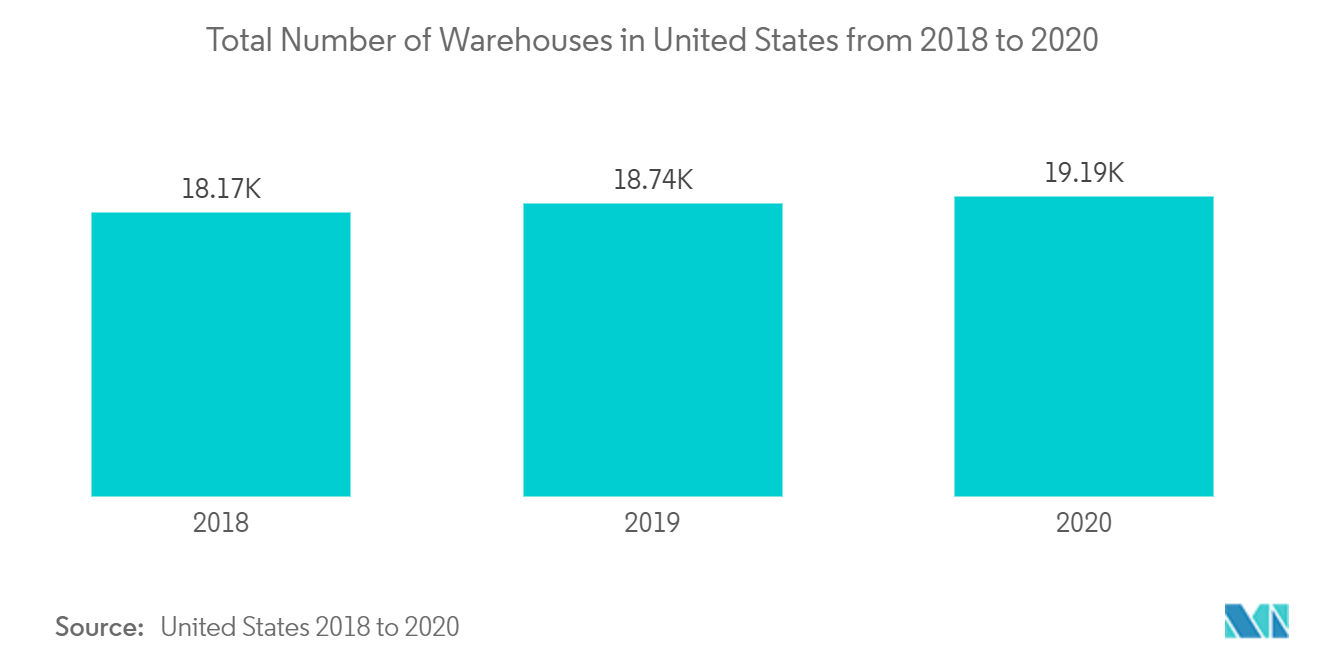Market Trends of North America Warehouse Automation Industry
This section covers the major market trends shaping the North America Warehouse Automation Market according to our research experts:
Increased Adoption of Robotics In The Warehouses Is Driving The Market
- A growing number of self-driving machines are shuttling clothing and sports equipment down warehouse aisles, pulling bins of groceries, cosmetics, and industrial parts from high stacks, and handing off goods to workers to help deliver orders faster. Some logistics operators are testing forklifts that can be operated remotely, allowing employers in tight labor markets to draw from a geographically broader pool of workers.
- According to a Ware2Go survey, 67% of Americans work from home. This means they have easy access to online shopping. E-commerce is more dependent than ever as the COVID-19 pandemic has changed how Americans shop. As a result, over half of U.S. companies are increasingly willing to invest in automation to respond to changing market conditions. The 2020 Honeywell Intelligrated Automation Investment study found that the e-commerce grocery(66%), food and beverage (59%), and logistics (55%) industries are most likely to invest more in automation.
- Some players are investing in developing disinfection robots due to the sudden increase In demand during the coronavirus pandemic. For instance, in April 2020, Ocado announced the launch of its first robotic automated warehouse in North America, which the Empire company would use to begin testing orders in Ontario, Canada. It is the second Ocado customer fulfillment center to be opened internationally in 2020.
- The market is also witnessing various partnerships to deploy automated solutions in the logistics sector. For instance, in May 2021, ABB robotics collaborated with Cam Industrial and Remtech Systems to introduce automation solutions for logistics and supply chains in Alberta and British Columbia to address the growing need for flexibility, speed, and accuracy in fulfillment centers based on consumer demand.
- Today's intelligent robots are well suited for the complex demands of omnichannel supply chains. For example, autonomous mobile robots (AMRs) have more agile navigation capabilities that allow them to navigate anywhere in the warehouse using built-in sensors and laser scanners to retrieve goods and deliver them to workers. As the U.S. workforce continues to work inside and outside this new workforce, automation will help businesses maximize these e-commerce opportunities and ensure that society has what it needs to thrive and prosper.

Growth In The E-commerce Industry and SKUs Proliferation.
- With the advent of always-on e-commerce and faster response times, the need to manage large numbers of error-free stock-keeping units (SKUs) are expanding warehouses, fulfillment centers, and intelligent and efficient standards. The urgent need to reduce costs, streamline operations and increase efficiency drives robot innovation. In addition, the economy is growing, and the demand for automation due to intensified competition in the retail e-commerce market in the region is driving the market's growth.
- Technological advances and market changes, such as the rise of omnichannel logistics, have required companies to add new items to their catalogs. Companies may increase the number of SKUs (Stock Keeping Units) sold to expand their customer portfolio. SKU spikes are a strategy aimed at increasing sales by stocking more products, and companies can serve more customers and, as a result, earn more sales.
- In April 2021, 3PL Central, one of the leaders in cloud-based Warehouse Management Systems (WMS), acquired Skubana, a leading inventory management system and e-commerce operations platform. With this acquisition, 3PL Central expanded its supply chain technology offering to include intelligent order routing and inventory management to provide an integrated fulfillment solution from the shopping cart to the warehouse.
- Similarly, in September 2020, Chewy company plans to drive automation of its entire fulfillment network over the next two years through new warehouse locations and remodeling existing facilities. Chewy opened a second automated fulfillment center in the second quarter and a "limited catalog facility" in the third quarter. Also, Chewy opened its first Limited SKU warehouse in the metropolitan area of Kansas City, Missouri, to respond to spikes in volume and avoid rapid transportation costs and split transportation.
- Also, as per the Materials Management & Distribution Report, just-in-time ordering, direct-to-consumer distribution, and shifting retailer-wholesaler relationships reduce the number of large-pallet orders. The growth of small, multiple SKU orders is forcing warehouses to automate. The availability of technology, in such cases, has led to an ease of deployment by decreasing the time and cost of re-designing the whole facility.


